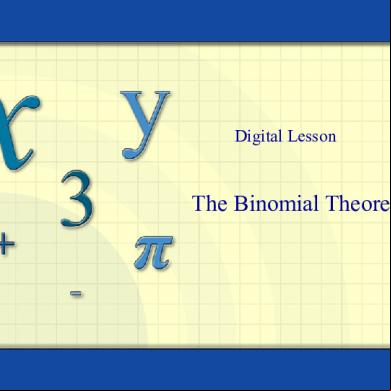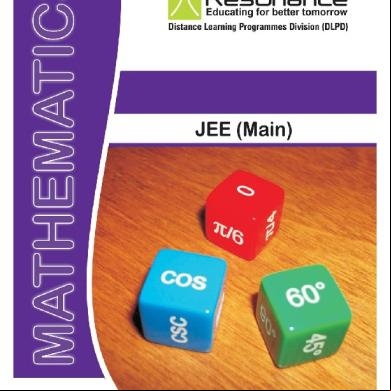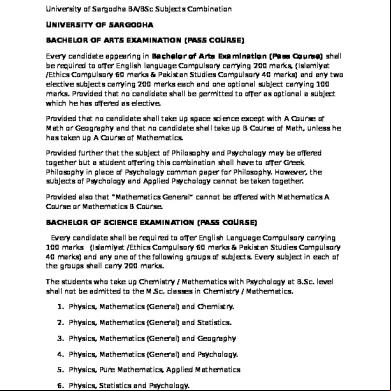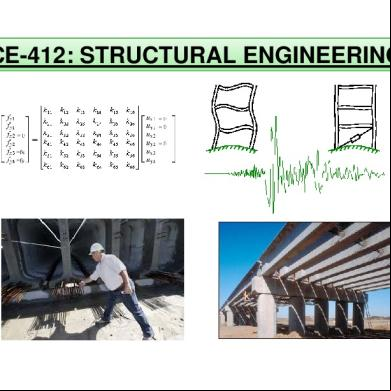This document was ed by and they confirmed that they have the permission to share it. If you are author or own the copyright of this book, please report to us by using this report form. Report 2z6p3t
Overview 5o1f4z
& View Binomial Theorem & Its Application as PDF for free.
More details 6z3438
- Words: 1,757
- Pages: 8
BINOMIAL THEOREM & ITS APPLICATION As bi means two and “nomials” means so binomial means two expansion. In this chapter, following sub topics will be discussed with example. Derivation of formula. Expansion of formula when power is a positive integer. Application with condition. The basic concept of binomial was taken from Pascal triangle which is given below. Write
1 1
1
Take sum of lower 1 1 and write in the third line in the centre of these 1 write 1 1 in beginning and end of these as mentioned below. 1 1 1
1 2
1
Take sum of lower 1 2 and 2 1 2 and 2 1 ,and write 1 below. 1 1 1 1
1, and
1and write in the fourth line in the centre of these 1 in beginning and end of these as mentioned
1 2
3
1 3
1
Take sum of lower 1 3 , 3 3 and 3 1 and write in the fifth line in the centre of these 1 3,3 3 and 3 1 ,and write 1 1 in beginning and end of these as mentioned below. 1 1 1 1 1
1 2
3 4
1 3
6
1 4
1
Take sum of lower 1 4 , 4 6 , 6 4 and 4 centre of these 1 4 , 4 6, 6 4 ,and 4 end of these as mentioned below. Pascal triangle will be formed as given below; 1 1 1 1
1 2
3
By: Mohammad Afrasiab www.facebook.com/guide.academy.isb
1 3
1
1 and write in the sixth line in the 1and write 1 1 in beginning and
1 1
4 5
6 10
4 10
1 5
1
And this procedure will be carried on. Now considering two (a + b); If (a + b) power is zero then
(a + b)0 =1
If (a + b) power is 1 then
(a + b)1 = a + b.
If (a + b) power is 2 then
(a + b)2 = a2 +2ab +b2.
If (a + b) power is 3 then
(a + b)3 = a3 +3a 2b +3ab2 +b3.
If (a + b) power is 4 then
(a + b)4 = a4 +4a 3b +6a 2b2 +4ab3+b4.
If (a + b) power is 5 then
(a + b)5 = a5 +5a 4b +10a 3b2 +10a 2b3+5ab4+b5
In the above expansions, it is observed that As power increases, the number of increases. As “a” power starts with the value of n and decreases in every successive term where “b” power starts from zero in the first term and increases in successive . The coefficients of “a” and “b” can be linked with Pascal triangle numbers as mentioned above. Relation between Pascal triangle and ( a + b)n ,where “n” is power. When n=0 , then (a + b)0 =1 and in 1 is the first number in first line of Pascal triangle. When n=1 , then (a + b)1 =a + b and in 1 1 are the numbers in second line of Pascal triangle which are coefficients of a,b. When n=2 , then (a + b)2 =a2 +2ab + b2 and in 1 2 1 are the numbers in third 2 line of Pascal triangle which are coefficients of a , ab and b2. When n=3 , then (a + b)3 = a3 +3a 2b +3ab2 +b3. and in 1 3 3 1 are the 3 numbers in fourth line of Pascal triangle which are coefficients of a , a 2b ab 2 and b3. When n=4 , then (a + b)4 = a4 +4a 3b +6a 2b2 +4ab3+b4. and in 1 4 6 4 1 are 4 3 2 2 the numbers in fifth line of Pascal triangle which are coefficients of a , a b , a b ,ab3 and b4. When n=5 , then (a + b)5 = a5 +5a 4b +10a 3b2 +10a 2b3+5ab4+b5 and in 1 5 10 10 5 1 are the numbers in sixth line of Pascal triangle which 5 4 3 2 are coefficients of a , a b , a b ,a2 b3 ab4 and b5 So in the same way (a + b)6 , (a +b)7 ……can be expanded. Note: When Pascal triangle is not applicable: If the coefficients of “a” and “b” are 1and 1, then this is applicable but if not 1 ,1 then it will not work. If the power is an positive integer then it works but not for other form of numbers. If the power is very large then it will be difficult to draw Pascal triangle. To overcome this difficulty, the concept of Combination will be used. n
Cr = _n!____ r! (n-r)!
By: Mohammad Afrasiab www.facebook.com/guide.academy.isb
Where “n” represents the power of (a + b) and “r” represents the required term. The sign “!” represents factorial sign and its values are given below: 0! =1 1! =1 2! =2x1=2 3!=3x2x1=6 4!=4x3x2x1=24 5!=5x4x3x2x1 =120 Now , 5
C2 =
(
)
8
C3 =
(
)
12
C5 =
(
)
So this will be used in binomial expansion with the following formula, (a + b) n =nC0 (a)n(b)0 + n-1C1(a)n-1(b)1+n-2C2(a)n-2(b)2 + n-3C3(a)n-3(b)3+………nCn(a)0(b)n Where n є Z+………….(1) OR ( (
)(
(
) )(
)
(
)(
)
)
----------(
Where
)
(
;
)(
)
(2)
(
;
)(
Expansion of (1+x)n and (1-x)n by binomial theorem ( )
(
( )
)
(
)
(
)(
)
(
)(
)(
)
)
(
)
(
)(
)
(
)(
)(
)
And (
If n =odd number then last term will be negative. If n =even number then last term will be positive. For any specific term or coefficient By: Mohammad Afrasiab www.facebook.com/guide.academy.isb
(
)
)(
)
(
)
(2a +3b)2 , (3a+4b)3 , (2x -3y)4.
Q=1. Expand Solution : 1.
(2a +3b)2 = 2C0(2a)2 +2C1(2a)(3b) + 2C2(3b)2 = 1x 4a2 +2x6ab +1x 9b2 = 4a2 +12ab + 9b2..
2.
(3a +4b)3 = 3C0(3a)3 +3C1(3a)2(4b) + 3C2 (3a)(4b)2 +3C3(4b)3 = 27a3 + 108a2b+144ab2 +64b3.
3.
(2x -3y)4 = 4
C0(2x)4 +4C1(2x)3(-3y)1 + 4C2 (2x)2(-3y)2 +4C3 (2x)(-3y)3+4C4(-3y)4 = 16x4 -96x3y + 216x2y2 – 216xy3 + 81y4.
Q =2 Expand (a +b)8. Solution: =8C0(a)8 +8C1(a)7(b)1 + 8C2 (a)6(b)2 +8C3 (a)(b)3+8C4(a)4(b)4 +8C5(a)3(b)5 +8C6(a)6(b)2 + 8C7 (a)7(b) +8C8 (b)8 =(a)8 +8(a)7(b)1 + 28 (a)6(b)2 +56 (a)5(b)3+70(a)4(b)4 +56(a)3(b)5 +28(a)6(b)2 + 8(a)7(b) + (b)8. Q=3 Expand (2x -y)5. Solution: = 5C0(2x)5 +5C1(2x)4(-y)1 + 5C2 (2x)3(-y)2 +5C3 (2x)2(-y)3+5C4(2x)(-y)4 +5C5(-y)5 = 32x5 -80x4y + 80x3y2 -40x2y3+10xy4 – y5. Q=4 expand (a +b)8 Solution: =8C0(a)8 +8C1(a)7(b)1 + 8C2 (a)6(b)2 +8C3 (a)5(b)3+8C4(a)4(b)4 + 8
C5(a)3(b)5+8C6(a)2(b)6 + 8C7 (a)(b)7 +8C8 (b)8
= a8 +8a7b + 28a6b2 +56a5b3+70a4y4 +56a3b5+28a2b6+8ab7+b8. Q=5 expand (a -b)8 Solution: By: Mohammad Afrasiab www.facebook.com/guide.academy.isb
=8C0(a)8 +8C1(a)7(-b)1 + 8C2 (a)6(-b)2 +8C3 (a)5(-b)3+8C4(a)4(-b)4 + 8
C5(a)3(-b)5+8C6(a)2(-b)6 + 8C7 (a)(-b)7 +8C8 (-b)8
= a8 - 8a7b + 28a6b2 -56a5b3+70a4y4 -56a3b5+28a2b6-8ab7+b8. Q=6 Simplify (a+b)8 - (a - b)8 Solution: As solved in Q=4&5, ={8C0(a)8 +8C1(a)7(b)1 + 8C2 (a)6(b)2 +8C3 (a)5(b)3+8C4(a)4(b)4 + 8
C5(a)3(b)5+8C6(a)2(b)6 + 8C7 (a)(b)7 +8C8 (b)8 }–{8C0(a)8 +8C1(a)7(-b)1 + 8C2 (a)6(-b)2 +8C3 (a)5(b)3+8C4(a)4(-b)4 +8C5(a)3(-b)5+8C6(a)2(-b)6 + 8C7 (a)(-b)7 +8C8 (-b)8 } = {a8 + 8a7b + 28a6b2 +56a5b3+70a4y4 +56a3b5+28a2b6+8ab7+b8}- { a8 - 8a7b + 28a6b2 56a5b3+70a4y4 -56a3b5+28a2b6-8ab7+b8} =16a7b+112a5b3+112a3b5+16ab7
(
Q=7:
)
. (
Solution: (
(
) (
)(
)
)
(
)
(
(
) (
)(
)
(
)
(
)(
)
)
)
Q=8 Find the 7th term of the following expansions of (2x-y)17. Solution: Using the formula,
(
)
(
)
Q=9 Find the middle term in the expansion of (
)10;
Solution: As power is 10 so number of will be eleven because the number of is always one more than the power if it is a positive integer. Hence 6th term will be the middle term.
( )
(
)
Q=10 Find the coefficient of x9, x10, term independent of x in the following expansion ( )20. Solution: For any coefficient, Use formula
Since specific term which contains x9, is not known, so first ‘r’ will be calculated. ( ( )
) (
( ) ) ( )
By: Mohammad Afrasiab www.facebook.com/guide.academy.isb
(
) ( )
--------------------(1)
a) ( )
. b) ( ) ( ) (
) ( )
(
)
c)
.
.
Q=11: (1+ax)n
1+6x+ x2, then find ‘a’ and ‘n’.
Solution: (
(
)
)
As it is given that (1+ax)n ( ) (
)
(
)
( )
1+6x+ x2------------------------(2)
( ) )
(
)
1+6x+ x2
(
(
(
( )
)
)
)
Q= 12: (a) If there is no term of x in the expansion of (1+4x)(1+ax)5, then find a. (b)For this value of ‘a’ find the coefficient of x2 in the expansion of (1+4x)(1+ax)5 Solution: (a) (
)(
( By: Mohammad Afrasiab www.facebook.com/guide.academy.isb
)
(b)
Q=13 In the expansion (k+x)8, the coefficient of x2 and x3 are equal, find the non zero constant k. Solution: (
(
)
)
(
(
)(
)
)
(
)(
)
Question from past papers: Q:1 Find the value of the coefficient of
in the expansion of (2x − )5.
[3]
Solution: The coefficient of ( ( )
)
(
( ) )(
( )
) ( )
(
) ( )
--------------------(1)
( ) ( )
(
) ( )
( ) ( )
( )
Q.2: Find the coefficient of x3 in the expansion of (i) ( ) , (ii) (1 − 3x)( ) . Solution: ) ( ) ( ) ( i) (
ii) (1 − 3x)(
)
(
[3] [3] )
)(
. Q.3: (i) Find the first 3 in the expansion of ( ) in ascending powers of x. (i) Find the value of k for which there is no term in x2 in the expansion of (1 + kx)( ) . Solution: ( )( ) ( )( ) ( ) By: Mohammad Afrasiab www.facebook.com/guide.academy.isb
)
[3] [2]
(
(
)
(ii) (1 + kx)(
)(
)
)( + --------
)
Q.4: The first three in the expansion of ( ) , in ascending powers of x, 2 are 32 − 40x + bx . Find the values of the constants n, a and b. [5] 2 Solution: ( ) 32 − 40x + bx (
(
)
)
(
)
; (
(
)
(
(
)
( )
)
By: Mohammad Afrasiab www.facebook.com/guide.academy.isb
(
)
)
1 1
1
Take sum of lower 1 1 and write in the third line in the centre of these 1 write 1 1 in beginning and end of these as mentioned below. 1 1 1
1 2
1
Take sum of lower 1 2 and 2 1 2 and 2 1 ,and write 1 below. 1 1 1 1
1, and
1and write in the fourth line in the centre of these 1 in beginning and end of these as mentioned
1 2
3
1 3
1
Take sum of lower 1 3 , 3 3 and 3 1 and write in the fifth line in the centre of these 1 3,3 3 and 3 1 ,and write 1 1 in beginning and end of these as mentioned below. 1 1 1 1 1
1 2
3 4
1 3
6
1 4
1
Take sum of lower 1 4 , 4 6 , 6 4 and 4 centre of these 1 4 , 4 6, 6 4 ,and 4 end of these as mentioned below. Pascal triangle will be formed as given below; 1 1 1 1
1 2
3
By: Mohammad Afrasiab www.facebook.com/guide.academy.isb
1 3
1
1 and write in the sixth line in the 1and write 1 1 in beginning and
1 1
4 5
6 10
4 10
1 5
1
And this procedure will be carried on. Now considering two (a + b); If (a + b) power is zero then
(a + b)0 =1
If (a + b) power is 1 then
(a + b)1 = a + b.
If (a + b) power is 2 then
(a + b)2 = a2 +2ab +b2.
If (a + b) power is 3 then
(a + b)3 = a3 +3a 2b +3ab2 +b3.
If (a + b) power is 4 then
(a + b)4 = a4 +4a 3b +6a 2b2 +4ab3+b4.
If (a + b) power is 5 then
(a + b)5 = a5 +5a 4b +10a 3b2 +10a 2b3+5ab4+b5
In the above expansions, it is observed that As power increases, the number of increases. As “a” power starts with the value of n and decreases in every successive term where “b” power starts from zero in the first term and increases in successive . The coefficients of “a” and “b” can be linked with Pascal triangle numbers as mentioned above. Relation between Pascal triangle and ( a + b)n ,where “n” is power. When n=0 , then (a + b)0 =1 and in 1 is the first number in first line of Pascal triangle. When n=1 , then (a + b)1 =a + b and in 1 1 are the numbers in second line of Pascal triangle which are coefficients of a,b. When n=2 , then (a + b)2 =a2 +2ab + b2 and in 1 2 1 are the numbers in third 2 line of Pascal triangle which are coefficients of a , ab and b2. When n=3 , then (a + b)3 = a3 +3a 2b +3ab2 +b3. and in 1 3 3 1 are the 3 numbers in fourth line of Pascal triangle which are coefficients of a , a 2b ab 2 and b3. When n=4 , then (a + b)4 = a4 +4a 3b +6a 2b2 +4ab3+b4. and in 1 4 6 4 1 are 4 3 2 2 the numbers in fifth line of Pascal triangle which are coefficients of a , a b , a b ,ab3 and b4. When n=5 , then (a + b)5 = a5 +5a 4b +10a 3b2 +10a 2b3+5ab4+b5 and in 1 5 10 10 5 1 are the numbers in sixth line of Pascal triangle which 5 4 3 2 are coefficients of a , a b , a b ,a2 b3 ab4 and b5 So in the same way (a + b)6 , (a +b)7 ……can be expanded. Note: When Pascal triangle is not applicable: If the coefficients of “a” and “b” are 1and 1, then this is applicable but if not 1 ,1 then it will not work. If the power is an positive integer then it works but not for other form of numbers. If the power is very large then it will be difficult to draw Pascal triangle. To overcome this difficulty, the concept of Combination will be used. n
Cr = _n!____ r! (n-r)!
By: Mohammad Afrasiab www.facebook.com/guide.academy.isb
Where “n” represents the power of (a + b) and “r” represents the required term. The sign “!” represents factorial sign and its values are given below: 0! =1 1! =1 2! =2x1=2 3!=3x2x1=6 4!=4x3x2x1=24 5!=5x4x3x2x1 =120 Now , 5
C2 =
(
)
8
C3 =
(
)
12
C5 =
(
)
So this will be used in binomial expansion with the following formula, (a + b) n =nC0 (a)n(b)0 + n-1C1(a)n-1(b)1+n-2C2(a)n-2(b)2 + n-3C3(a)n-3(b)3+………nCn(a)0(b)n Where n є Z+………….(1) OR ( (
)(
(
) )(
)
(
)(
)
)
----------(
Where
)
(
;
)(
)
(2)
(
;
)(
Expansion of (1+x)n and (1-x)n by binomial theorem ( )
(
( )
)
(
)
(
)(
)
(
)(
)(
)
)
(
)
(
)(
)
(
)(
)(
)
And (
If n =odd number then last term will be negative. If n =even number then last term will be positive. For any specific term or coefficient By: Mohammad Afrasiab www.facebook.com/guide.academy.isb
(
)
)(
)
(
)
(2a +3b)2 , (3a+4b)3 , (2x -3y)4.
Q=1. Expand Solution : 1.
(2a +3b)2 = 2C0(2a)2 +2C1(2a)(3b) + 2C2(3b)2 = 1x 4a2 +2x6ab +1x 9b2 = 4a2 +12ab + 9b2..
2.
(3a +4b)3 = 3C0(3a)3 +3C1(3a)2(4b) + 3C2 (3a)(4b)2 +3C3(4b)3 = 27a3 + 108a2b+144ab2 +64b3.
3.
(2x -3y)4 = 4
C0(2x)4 +4C1(2x)3(-3y)1 + 4C2 (2x)2(-3y)2 +4C3 (2x)(-3y)3+4C4(-3y)4 = 16x4 -96x3y + 216x2y2 – 216xy3 + 81y4.
Q =2 Expand (a +b)8. Solution: =8C0(a)8 +8C1(a)7(b)1 + 8C2 (a)6(b)2 +8C3 (a)(b)3+8C4(a)4(b)4 +8C5(a)3(b)5 +8C6(a)6(b)2 + 8C7 (a)7(b) +8C8 (b)8 =(a)8 +8(a)7(b)1 + 28 (a)6(b)2 +56 (a)5(b)3+70(a)4(b)4 +56(a)3(b)5 +28(a)6(b)2 + 8(a)7(b) + (b)8. Q=3 Expand (2x -y)5. Solution: = 5C0(2x)5 +5C1(2x)4(-y)1 + 5C2 (2x)3(-y)2 +5C3 (2x)2(-y)3+5C4(2x)(-y)4 +5C5(-y)5 = 32x5 -80x4y + 80x3y2 -40x2y3+10xy4 – y5. Q=4 expand (a +b)8 Solution: =8C0(a)8 +8C1(a)7(b)1 + 8C2 (a)6(b)2 +8C3 (a)5(b)3+8C4(a)4(b)4 + 8
C5(a)3(b)5+8C6(a)2(b)6 + 8C7 (a)(b)7 +8C8 (b)8
= a8 +8a7b + 28a6b2 +56a5b3+70a4y4 +56a3b5+28a2b6+8ab7+b8. Q=5 expand (a -b)8 Solution: By: Mohammad Afrasiab www.facebook.com/guide.academy.isb
=8C0(a)8 +8C1(a)7(-b)1 + 8C2 (a)6(-b)2 +8C3 (a)5(-b)3+8C4(a)4(-b)4 + 8
C5(a)3(-b)5+8C6(a)2(-b)6 + 8C7 (a)(-b)7 +8C8 (-b)8
= a8 - 8a7b + 28a6b2 -56a5b3+70a4y4 -56a3b5+28a2b6-8ab7+b8. Q=6 Simplify (a+b)8 - (a - b)8 Solution: As solved in Q=4&5, ={8C0(a)8 +8C1(a)7(b)1 + 8C2 (a)6(b)2 +8C3 (a)5(b)3+8C4(a)4(b)4 + 8
C5(a)3(b)5+8C6(a)2(b)6 + 8C7 (a)(b)7 +8C8 (b)8 }–{8C0(a)8 +8C1(a)7(-b)1 + 8C2 (a)6(-b)2 +8C3 (a)5(b)3+8C4(a)4(-b)4 +8C5(a)3(-b)5+8C6(a)2(-b)6 + 8C7 (a)(-b)7 +8C8 (-b)8 } = {a8 + 8a7b + 28a6b2 +56a5b3+70a4y4 +56a3b5+28a2b6+8ab7+b8}- { a8 - 8a7b + 28a6b2 56a5b3+70a4y4 -56a3b5+28a2b6-8ab7+b8} =16a7b+112a5b3+112a3b5+16ab7
(
Q=7:
)
. (
Solution: (
(
) (
)(
)
)
(
)
(
(
) (
)(
)
(
)
(
)(
)
)
)
Q=8 Find the 7th term of the following expansions of (2x-y)17. Solution: Using the formula,
(
)
(
)
Q=9 Find the middle term in the expansion of (
)10;
Solution: As power is 10 so number of will be eleven because the number of is always one more than the power if it is a positive integer. Hence 6th term will be the middle term.
( )
(
)
Q=10 Find the coefficient of x9, x10, term independent of x in the following expansion ( )20. Solution: For any coefficient, Use formula
Since specific term which contains x9, is not known, so first ‘r’ will be calculated. ( ( )
) (
( ) ) ( )
By: Mohammad Afrasiab www.facebook.com/guide.academy.isb
(
) ( )
--------------------(1)
a) ( )
. b) ( ) ( ) (
) ( )
(
)
c)
.
.
Q=11: (1+ax)n
1+6x+ x2, then find ‘a’ and ‘n’.
Solution: (
(
)
)
As it is given that (1+ax)n ( ) (
)
(
)
( )
1+6x+ x2------------------------(2)
( ) )
(
)
1+6x+ x2
(
(
(
( )
)
)
)
Q= 12: (a) If there is no term of x in the expansion of (1+4x)(1+ax)5, then find a. (b)For this value of ‘a’ find the coefficient of x2 in the expansion of (1+4x)(1+ax)5 Solution: (a) (
)(
( By: Mohammad Afrasiab www.facebook.com/guide.academy.isb
)
(b)
Q=13 In the expansion (k+x)8, the coefficient of x2 and x3 are equal, find the non zero constant k. Solution: (
(
)
)
(
(
)(
)
)
(
)(
)
Question from past papers: Q:1 Find the value of the coefficient of
in the expansion of (2x − )5.
[3]
Solution: The coefficient of ( ( )
)
(
( ) )(
( )
) ( )
(
) ( )
--------------------(1)
( ) ( )
(
) ( )
( ) ( )
( )
Q.2: Find the coefficient of x3 in the expansion of (i) ( ) , (ii) (1 − 3x)( ) . Solution: ) ( ) ( ) ( i) (
ii) (1 − 3x)(
)
(
[3] [3] )
)(
. Q.3: (i) Find the first 3 in the expansion of ( ) in ascending powers of x. (i) Find the value of k for which there is no term in x2 in the expansion of (1 + kx)( ) . Solution: ( )( ) ( )( ) ( ) By: Mohammad Afrasiab www.facebook.com/guide.academy.isb
)
[3] [2]
(
(
)
(ii) (1 + kx)(
)(
)
)( + --------
)
Q.4: The first three in the expansion of ( ) , in ascending powers of x, 2 are 32 − 40x + bx . Find the values of the constants n, a and b. [5] 2 Solution: ( ) 32 − 40x + bx (
(
)
)
(
)
; (
(
)
(
(
)
( )
)
By: Mohammad Afrasiab www.facebook.com/guide.academy.isb
(
)
)










